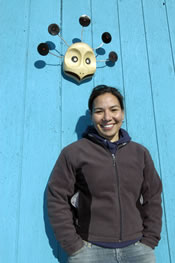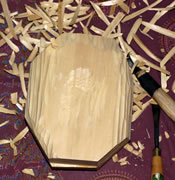Mask maker brings wood to life
By Carol Gales, Northwest Campus, Nome
October 2006
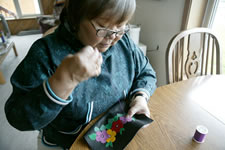
![]()
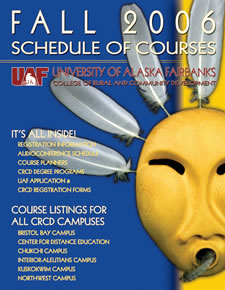
A photograph of the second mask Larson carved is featured on the cover of the fall
2006 schedule for the College of Rural and Community Development at UAF.
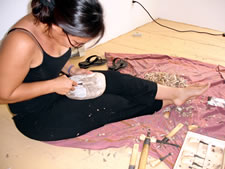

Jonella Larson grew up in a world filled with art. Her mother, who was raised on St. Lawrence Island, is an accomplished sewer and artistic designer of mukluks, sealskin parkas, kuspuks and other Native clothing.
Larson’s relatives on the island can barely keep up with demand for their detailed, lifelike ivory pieces. "I’ve been surrounded by art all my life," Larson said.
Yet, Larson’s own creative vein was tapped not at home in Nome, but in Alvin Amason’s Alaska Native arts course at the University of Alaska Fairbanks. She carved a mask and a ladle that semester of her senior year. Since then, she has carved nine other masks.
Her second mask--the only one she has not sold or given away--appears on the cover of the College of Rural and Community Development’s fall 2006 schedule. Larson began working on that mask upon her return home to Nome after she completed a bachelor’s degree in rural development at UAF in 2000.
She wanted to inject personality into the piece through its eyes and nose. Having heard the nose of a mask was often shaped to represent a whale’s tail, she tried that. She also echoed old masks by placing a feather in the mouth of the piece. Larson had learned that, historically, after a mask had been used for its designated purpose, it was often hung over a doorway with a feather placed in its mouth. Movement through the door caused the feather to move, animating the mask.
Larson is not aware of a mask-making tradition within her own St. Lawrence Island Yupik culture. Instead, she studies old Central Yup’ik masks and masks from King Island for inspiration and ideas. She is also drawn to masks from other indigenous traditions in America and beyond.
She usually works with yellow cedar or driftwood. Her pieces never turn out the way she first envisions them. "It can take a long while before something comes out," she said.
Her creative process involves keeping a particular person or event in mind while carving. "I try to put good thoughts and good energy into the piece," she said.
One of her most personal and meaningful works emerged from a family tragedy. Several of her cousins had committed suicide over a short period of time. While trying to deal with these shocking deaths, Larson began to carve. She focused on good memories of these cousins and positive thoughts about village life. While her fingers and tools sought a face in a piece of wood, she questioned what it would take to end suicide in Native communities.
Larson sold the mask in 2003 during a show at Quintanna Galleries, a contemporary Native arts gallery in Portland, Ore. The buyer, she later learned, was a counselor in Seattle who works with Native youth.
Larson’s newest works, "Owl Mask" and "Drum Song," are part of a Seattle gallery show this fall featuring work from the Bering Strait region. The pieces include carved baleen, ivory and beads.
Meanwhile, Larson is pursuing a master’s degree in museum studies at Harvard University this fall. She’ll bring to class her art background and experience working at museums and art galleries. She spent the past year planning a cultural center for the Bering Strait region. Larson hopes that when the center opens it will feature contemporary Native work, as well as the more commonly seen pieces created for the tourist trade by recent generations.
"There are ivory carvings that portray mammals and birds very accurately, and that’s a beautiful art form in itself," she said. "But we also need to support those who are interested in using other mediums--glass, metal, alabaster, marble, painting, glassblowing, sewing, fashion--it’s endless."
Since she lives life surrounded by art, clearly Jonella Larson hopes to share her passion with others.
For more information please contact:
-
Carol Gales, program development manager, Northwest Campus, (907) 443-8407, carol.gales@uaf.edu.
-
Jonella Larson, jonellalarson@hotmail.com
Other useful links:
- UAF Department of Art
- Stonington Gallery
- Alaska Native Artists
- The Alaskan Native Carver's Gallery
- UA Museum of the North



